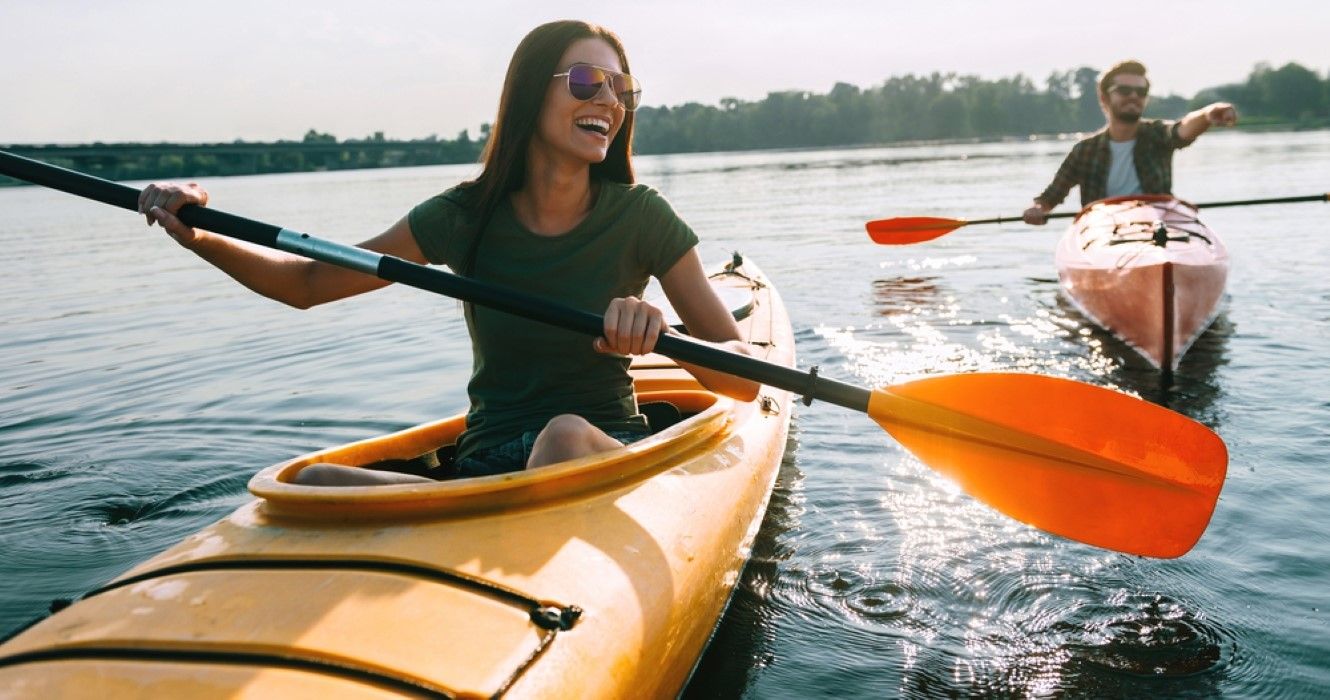Quick Links
Setting off in a kayak can sound both intimidating and inviting. Paddling around a lake or other body of water can be a great form of exercise, but it's also a fantastic way to be immersed in nature.
One of the most appealing things about kayaking is it can be done for free, even in places like New York City. It's also a sport that can be enjoyed year-round, though falling into the drink during winter won't be a thrilling time.
To lower the chances of getting dumped into the water and avoid seriously risky circumstances, there are a few techniques and tips brand-new kayakers should know.
What To Pack When Kayaking
Kayaking isn't the type of activity that requires a lot of gear. After all, the more weight that's added to the craft, the harder it will be to skim over the water. But there are some essentials that should go on every kayaker's packing list.
Depending on the length of the trip (read: how far from shore/help), it's smart to bring along the basics like sun protection (sunscreen is great, sun-blocking clothes and a hat are better), bug repellent, and a first aid kit.
Then, consider the following kayak-specific kit:
- A personal flotation device that's properly fitted
- Dry bag(s) for personal items (like a smartphone and/or radio)
- A headlamp (or at the very least, a flashlight)
- Some means of emergency communication; a whistle is handy and cheap
- Any licenses or permits, as needed
- Water; Kayaking is demanding and often involves sun and heat exposure. A gallon of water is a good idea, as it should last a full day if needed.
Bathroom supplies are their own separate item, depending on location and the amenities available.
After all, sometimes even kayakers have to make a pit stop for those pesky nature calls.
How To Launch Your Kayak
When you first step into a kayak that's close to land, it will feel extremely wobbly. The good news is that kayaks are built to balance well on the water — at least once you sit down.
Getting in is usually the trickiest part because once you're on the water, the kayak's shape lends itself to easily gliding atop the water and even handling small waves with ease.
The easiest way to launch your kayak is by sliding it into the water at the shore, where the beach gradually slopes (try to avoid sliding or dragging, though).
First, grab your paddle — lay it across the kayak, if there's something it can rest on (a strap or indentation), or slide it length-wise into the body of the kayak, so it rests next to where you'll sit.
Then, step over the kayak, so one leg is on either side. Sit down slowly.
If you have shorter legs, or the shoreline isn't as gradually sloped as you'd hope, you may be able to put one leg in, sit most of the way down, then pull the other leg up.
However, this makes for a wobbly start, so be careful!
Paddling Tips For Kayaking
There are plenty of techniques for kayak paddling, but the honest truth is that for beginners, the focus is on keeping the kayak moving and preventing exhaustion.
To do both, don't overexert while paddling; relax the arms, keep elbows bent, and use deep rowing motion, not multiple splishy-splashy, fast movements.
That said, it all starts with a kayaker's posture; you should sit upright, knees slightly bent, and feet on the foot pedals. This position helps stabilize against small waves or obstacles in the water.
Then, remember to keep movements deliberate. Any quick, jerky movement could cause the kayak to capsize.
Yet if it does capsize, it doesn't help to panic.
What To Do If Your Kayak Capsizes
Sometimes a moment of panic, or sheer inexperience, can cause the kayak to flip. It's not easy to get back into a kayak in the middle of a lake, let alone solo, but it is possible to self-rescue.
It all comes down to maintaining balance and positioning the body evenly across the kayak to hold it steady while climbing aboard.
Kayak Touring instructs capsized kayakers to reach across the kayak and slowly pull themselves up across the craft.
Of course, the preferable move is to get the kayak back to shore, if possible, before attempting to get back in!
Tips For Beginner Kayakers
Here are a few general tips to keep in mind while kayaking for the first time (or first few times):
- Always prepare as if you'll wind up in the water. Wear your life vest and use waterproof bags for electronics.
- Start with short trips close to shore. It's best to start on a lake or other relatively stagnant body of water; ocean waves and river currents can be tough for beginners to handle.
- Avoid windy or cloudy days. Weather can change quickly, and wind alone can pose a hazard. A lightning storm or downpour? Way worse.
- Safety first; bring a friend, stay within sight of someone on shore, or carry a radio and/or smartphone that has a signal. Better yet, do all three!
- Stay away from larger crafts. If you're kayaking where boats, jet skis, or any other powered craft are permitted, steer clear. Though common courtesy is to not encroach on others' space, kayakers (and other small craft) should take extra precautions.
After mastering the basics, most kayakers go on to tackle more challenging waterways and, often, upgrade their equipment. There are countless ways to enhance the kayaking experience while keeping safety in mind.
And with so many kayaking locations around the world, including scenic trips like the Wekiva River in Florida, of all places, kayakers will never run out of places to explore!

